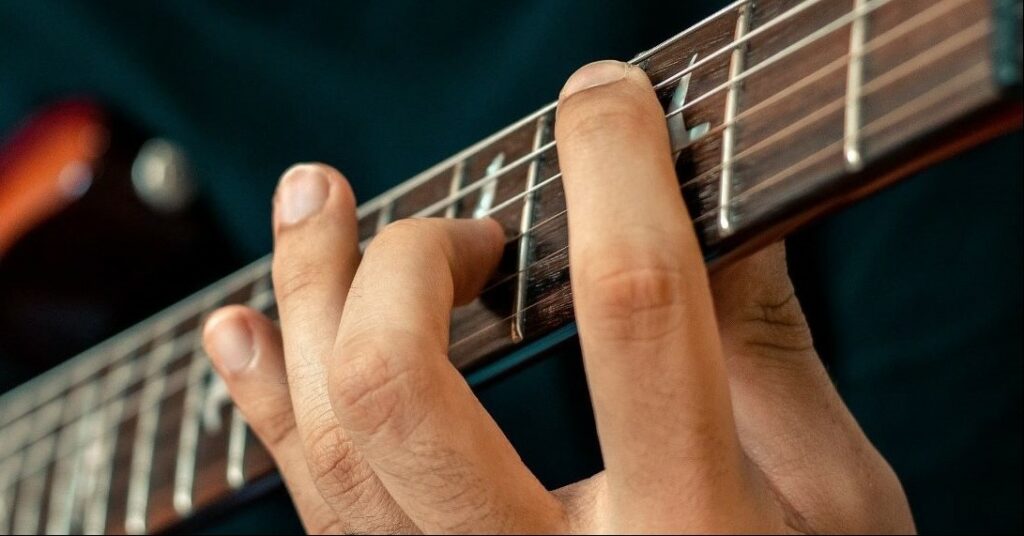Around 2/3 of Fender electric guitars have a 9.5″ fretboard radius which was introduced in the ’80s. The next most common Fender fingerboard radius is 7.25″ which is used on vintage inspired guitars. The 7.25″ radius was used on most Fender guitars between the ’50s and ’80s.
The fingerboard radius of a guitar has a big impact on how it feels to play, but is still an often overlooked specification as most players focus on neck depth (thickness) and shape when choosing a new guitar.
So what actually is the difference between a 7.25″ and 9.5″ radius. If you’re in a rush, here’s the quick answer…
A 7.25″ fingerboard radius feels more curved than a 9.5″ fingerboard radius which feels flatter. A 7.25″ fingerboard radius can feel easier for holding chords, whereas a 9.5″ fingerboard radius is often preferred for lead playing as it is easier to bend the strings and have a lower action.
| 7.25” Fingerboard Radius | 9.5” Fingerboard Radius |
| Feels more curved | Feels flatter |
| Good for chords | Good for bends |
| Harder to get a lower action | Easier to get a lower action |
| Used primarily between the ‘50s and ’80s and on vintage-inspired models | More modern radius used since the ‘80s on most Fender guitars |

Fingerboard Radius 101
All guitar fretboards have some degree of curvature. The fingerboard/ fretboard radius is a measurement of how much curvature it has.
- Larger fingerboard radius = flatter fingerboard
- Smaller fingerboard radius = more curved fretboard
This sounds a little confusing at first, so let me explain.
The radius of a circle is the length from the centre to the edge of the shape.
Now image the cross-section of a guitar neck. If you take two necks which have the same fretboard width and try and align the curvature of the fretboard within a circle, you’ll notice that the smaller the circle, the more curved the fretboard needs to be to stay aligned.
Here’s a diagram to demonstrate.

Don’t worry if you don’t want to think about the maths and find the concept confusing. All you really need to remember is that a larger radius equals a flatter fretboard, and a smaller radius equals a more curved fretboard.
Advantage of a 7.25″ Radius
So know we know that a fingerboard with a 7.25″ radius is more curved than a fingerboard with a 9.5″ radius, let’s consider what impact this actually has on feel and playability.
The main advantage of a 7.25″ fingerboard radius (over a 9.5″ radius) is that it’s makes it easier to hold chords. This is because having more curvature fits the natural ergonomics of the hand more when holding a chord. This is the same for both open and barre chords.
For this reason, smaller fingerboard radiuses are very popular amongst rhythm guitar players.
Advantages of a 9.5″ Radius
The main advantages of a 9.5″ fingerboard radius (over a 7.25″ radius) are:
- It makes it easier to play quickly (better for shredding)
- It makes it easier to bend the strings
- The strings can be set at a lower action
A larger fingerboard radius makes the fingerboard feel flatter which is useful when shredding. The reason being that the fingers don’t need to travel more distance to reach from the high to the low strings, as there is less curvature.
This is one of the reasons why a 9.5″ radius is often considered better for players with smaller hands compared to a 7.25″ radius. However, it is quite subjective.
A larger fingerboard radius means the strings are less likely to “choke out” when bending. However, it doesn’t mean you can’t bend with a smaller radius. You should be able to bend strings with any radius, as long as the guitar is set up properly.
Speaking of setup, having a larger fingerboard radius makes it easier to set the strings at a lower action without experiencing fret buzz.
The “action” of a guitar refers to the height of the strings in relation to the fingerboard. Many players prefer a lower action because it makes it easier to fret the strings. Again, this is useful for fast playing, and even beginners who lack finger strength.

What is the Ideal Fingerboard Radius?
This is a highly subjective question and I’d really recommend you go to your local guitar store and try guitars with a different fingerboard radius to really figure out which you prefer the feel of.
With that said, a 9.5″ fingerboard radius is typically the more popular choice compared to a 7.25″ fingerboard radius.
A 9.5″ radius is considered a very moderate radius, as some guitars can go up to as high as 20″.
A 7.25″ radius on the other hand is considered very small, and there are very few guitars with a more curved fretboard than this. Hence, it’s more extreme and fewer players prefer it.
If you can’t try either guitar in person, going for the one with a 9.5″ radius is the safer choice.
Fingerboard Radius of Fender Guitars
Here’s a list of current Squier and Fender guitars with these fingerboard radiuses.
Fender Guitars with a 7.25″ Fingerboard Radius:
- Fender American Vintage
- Fender Vintera
Fender/ Squier Guitars with a 9.5″ Fingerboard Radius:
- Fender American Professional II Series Guitars
- Fender American Performer
- Fender American Original ’50s and ’60s Series Guitars
- Fender Player Series Guitars
- Fender Vintera Modified Series Guitars
- Squier Guitars
In the market for a new Fender? Check out my complete guide to Fender neck shapes.
